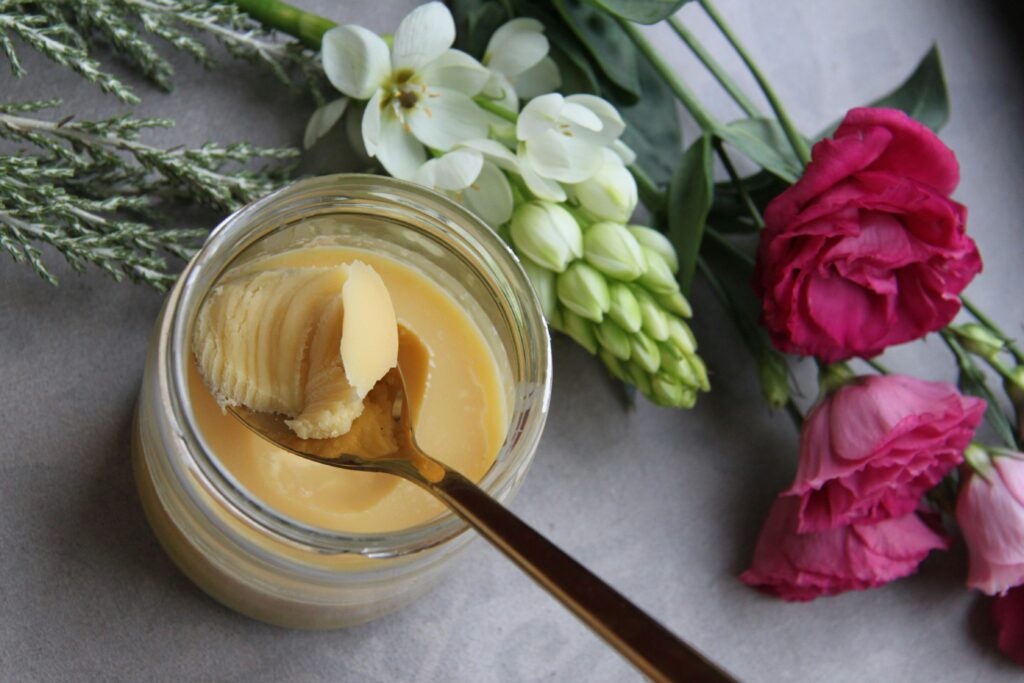Ghee, a type of clarified butter which originated in India, is produced by simmering cultured butter until the milk solids and fats are separated, wherein a rich, nutty, and aromatic oil is systematically refined out of a cow’s milk.
Health Benefits
Growing up on a standard American diet, I did not have regular access to Ghee, and it was not until I learned to add it to my morning coffee that I realized its potent health benefits. Ghee, abundant in Vitamins A, D, E, and K — has a distinct rejuvenating quality, alleviating such chronic health issues like indigestion and joint inflammation.

In Ayurvedic medicine, Ghee increases kapha, which is one of the three natural humors (dosha) the Vedic tradition recognized as governing the human physiology, in addition to both vata and pitta. Kapha is the resultant bio-energy formed from the elements of Earth and Water, with its moist, heavy, dense, and cold characteristics.
In the human body, kapha manifests structurally as the substance which endows our tissues with stability, cohesion, and lubrication. When kapha is balanced in one’s constitution, upon healthy digestion it is refined into ojas, which bestows one’s body with adequate immunity, strength, and vitality.
The health benefits which the Vedic tradition ascribed to Ghee are evidenced by this modern study1 which observed that the Butyric Acid in Ghee has the capacity to produce killer T cells in the GI tract. In addition to the ability to enhance immunity, the short-chain fatty acids like Butyric Acid also assist in promoting digestion by strengthening the intestinal wall, and therefore potentially healing intestinal permeability (leaky gut syndrome).
When digestion is not functioning properly, the human body accumulates undigested food matter in the gut, referred to as Ama, which creates a state of chronic toxicity in the body’s tissues. Therefore, Ghee was seen as a panacea for many illnesses not only because of its capacity to produce ojas, but also from its ability to stimulate the digestive fire, known as agni, that allows food to be properly absorbed; thereby allowing one to be physically nourished.
Vedic Ghee Recipe
Making ghee from raw cream
Most people do not have the ability to produce by themselves the numerous toxic seed oils that populate grocery stores, but on the contrary are able to obtain all the health benefits of Ghee in a few steps:
- In a mixer, churn raw cream until the cream separates into butter and buttermilk
- Strain the buttermilk and put the butter into a saucepan
- Bring the butter to a simmer, allowing the milk solids to separate from the fat
- When the golden color and nutty-aroma of ghee is achieved, strain the ghee into a separate container from the milk solids
And that is all!
If you do not make your own Ghee, then it is important to buy a high quality, grass-fed product. I like to buy this A2 Desi Ghee, as it is made with the traditional bilona method and is much more aromatic than non-Vedic Ghee products.
But if the pricer A2 Ghee is not an economically viable option, then a jar of this Grass-Fed Ghee is sure to be a great alternative.
- Kataria, Deepshikha, and Gurmeet Singh. “Health benefits of ghee: Review of Ayurveda and modern science perspectives.” Journal of Ayurveda and integrative medicine vol. 15,1 (2024) ↩︎